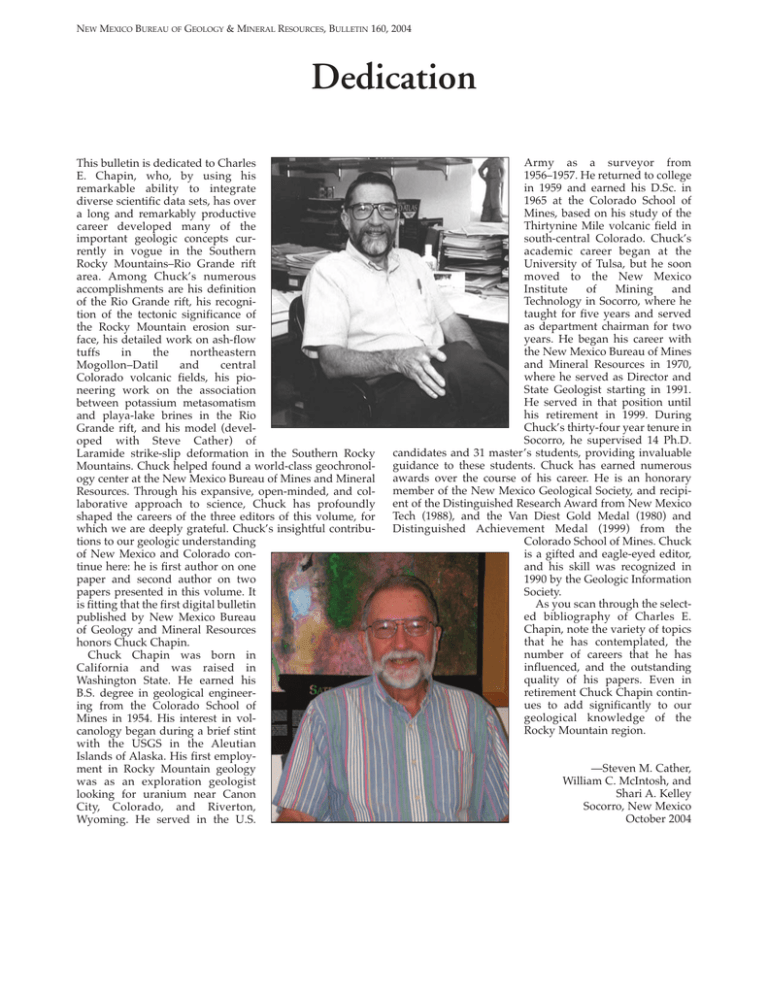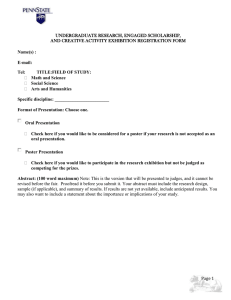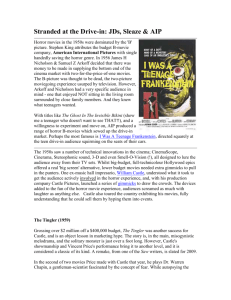Dedication
advertisement

NEW MEXICO BUREAU OF GEOLOGY & MINERAL RESOURCES, BULLETIN 160, 2004 Dedication This bulletin is dedicated to Charles E. Chapin, who, by using his remarkable ability to integrate diverse scientific data sets, has over a long and remarkably productive career developed many of the important geologic concepts cur­ rently in vogue in the Southern Rocky Mountains–Rio Grande rift area. Among Chuck’s numerous accomplishments are his definition of the Rio Grande rift, his recogni­ tion of the tectonic significance of the Rocky Mountain erosion sur­ face, his detailed work on ash­flow tuffs in the northeastern Mogollon–Datil and central Colorado volcanic fields, his pio­ neering work on the association between potassium metasomatism and playa­lake brines in the Rio Grande rift, and his model (devel­ oped with Steve Cather) of Laramide strike­slip deformation in the Southern Rocky Mountains. Chuck helped found a world­class geochronol­ ogy center at the New Mexico Bureau of Mines and Mineral Resources. Through his expansive, open­minded, and col­ laborative approach to science, Chuck has profoundly shaped the careers of the three editors of this volume, for which we are deeply grateful. Chuck’s insightful contribu­ tions to our geologic understanding of New Mexico and Colorado con­ tinue here: he is first author on one paper and second author on two papers presented in this volume. It is fitting that the first digital bulletin published by New Mexico Bureau of Geology and Mineral Resources honors Chuck Chapin. Chuck Chapin was born in California and was raised in Washington State. He earned his B.S. degree in geological engineer­ ing from the Colorado School of Mines in 1954. His interest in vol­ canology began during a brief stint with the USGS in the Aleutian Islands of Alaska. His first employ­ ment in Rocky Mountain geology was as an exploration geologist looking for uranium near Canon City, Colorado, and Riverton, Wyoming. He served in the U.S. Army as a surveyor from 1956–1957. He returned to college in 1959 and earned his D.Sc. in 1965 at the Colorado School of Mines, based on his study of the Thirtynine Mile volcanic field in south­central Colorado. Chuck’s academic career began at the University of Tulsa, but he soon moved to the New Mexico Institute of Mining and Technology in Socorro, where he taught for five years and served as department chairman for two years. He began his career with the New Mexico Bureau of Mines and Mineral Resources in 1970, where he served as Director and State Geologist starting in 1991. He served in that position until his retirement in 1999. During Chuck’s thirty­four year tenure in Socorro, he supervised 14 Ph.D. candidates and 31 master’s students, providing invaluable guidance to these students. Chuck has earned numerous awards over the course of his career. He is an honorary member of the New Mexico Geological Society, and recipi­ ent of the Distinguished Research Award from New Mexico Tech (1988), and the Van Diest Gold Medal (1980) and Distinguished Achievement Medal (1999) from the Colorado School of Mines. Chuck is a gifted and eagle­eyed editor, and his skill was recognized in 1990 by the Geologic Information Society. As you scan through the select­ ed bibliography of Charles E. Chapin, note the variety of topics that he has contemplated, the number of careers that he has influenced, and the outstanding quality of his papers. Even in retirement Chuck Chapin contin­ ues to add significantly to our geological knowledge of the Rocky Mountain region. —Steven M. Cather, William C. McIntosh, and Shari A. Kelley Socorro, New Mexico October 2004 Selected Bibliography Books Chapin, C. E., and Elston, W. E., 1978, Field guide to selected caul­ drons and mining districts of the Datil–Mogollon volcanic field, New Mexico: New Mexico Geological Society, Special Publication 7, 149 p., 3 pls. Chapin, C. E., and Elston, W. E., 1979, Ash­flow tuffs: Geological Society of America, Special Paper 180, 212 p. Chapin, C. E., and Callender, J. F., 1983, Socorro Region II: New Mexico Geological Society, 34th Annual Field Conference, Guidebook, 344 p. Chapin, C. E., and Zidek, J., 1989, Field excursions to volcanic ter­ ranes in the western United States, Volume I—Southern Rocky Mountain Region: New Mexico Bureau of Mines and Mineral Resources, Memoir 46, 486 p. Chapin, C. E., and Zidek, J., 1989, Field excursions to volcanic ter­ ranes in the western United States, Volume II—Cascades and Intermountain West: New Mexico Bureau of Mines and Mineral Resources, Memoir 47, 285 p. Lipman, P. W., Chapin, C. E., and Dungan, M. A., 1989, Cenozoic volcanism in the western United States: American Geophysical Union, 730 p. Papers Epis, R. C., and Chapin, C. E., 1968, Geologic history of the Thirtynine Mile volcanic field, central Colorado; in Epis, R. C. (ed.), Cenozoic volcanism in the southern Southern Rocky Mountains: Colorado School of Mines Quarterly, v. 63, no. 3, pp. 51–85. Chapin, C. E., 1971, The Rio Grande rift;, Part I—Modifications and additions; in: James, H. L. (ed.), San Luis Basin: New Mexico Geological Society, 22nd Annual Field Conference, Guidebook 22, pp. 191–201. Epis, R. C., and Chapin, C. E., 1974, Stratigraphic nomenclature of the Thirtynine Mile volcanic field, central Colorado: U.S. Geological Survey Bulletin 1395­C, 23 p. Epis, R. C., and Chapin, C. E., 1975, Geomorphic and tectonic impli­ cations of the post­Laramide, late Eocene erosion surface in the southern Southern Rocky Mountains; in Curtis, B. F. (ed.), Cenozoic evolution of the southern Southern Rocky Mountains: Geological Society of America, Memoir 144, pp. 45­–74. Chapin, C. E., and Lowell, G. R., 1979, Primary and secondary flow structures in ash­flow tuffs of the Gribbles Run paleovalley, cen­ tral Colorado; in Chapin, C. E., and Elston, W. E. (eds.), Ash­flow tuffs: Geological Society of America, Special Paper 180, pp. 137–154. (Reprinted in Cenozoic Volcanism in the Western United States, American Geophysical Union, 1989, pp. 466–483.) Brown, L. E., Chapin, C. E., Sanford, A. R., Kaufman, S., and Oliver, J., 1980, Deep structure of the Rio Grande rift from seismic reflec­ tion profiling: Journal of Geophysical Research, v. 85, pp. 4773–4800. Chapin, C. E., and Cather, S. M., 1981, Eocene tectonics and sedi­ mentation in the Colorado Plateau–­Rocky Mountain area; in Dickinson, W. R., and Payne, M. D. (eds.), Relations of tectonics to ore deposits in the southern cordillera: Arizona Geological Society Digest, v. 14, p. 173–198. (Reprinted in Rocky Mountain foreland basins and uplifts, Lowell, J. D., (ed.), Rocky Mountain Association of Geologists, 1983, pp. 33–56.). Chapin, C. E., 1983, An overview of Laramide wrench faulting in the southern Rocky Mountains with emphasis on petroleum exploration; in Lowell, J. D. and Gries, R. R. (eds.), Rocky Mountain foreland basins and uplifts: Rocky Mountain Association of Geologists, pp. 169–179. Osburn, G. R., and Chapin, C. E., 1983, Nomenclature for Cenozoic rocks of northeast Mogollon–Datil volcanic field, New Mexico: New Mexico Bureau of Mines and Mineral Resources, Stratigraphic Chart 1, text, scale 1:1,000,000. Chapin, C. E., Harlan, H. M., Bondurant, K. T., and others, 1983, The Hansen uranium orebody, Tallahassee Creek district, Fremont County, Colorado; in The genesis of Rocky Mountain ore deposits—Changes with time and tectonics: Denver Region, Exploration Geologists Society, pp. 117–123. Chapin, C. E., and Lindley, J. I., 1986, Potassium metasomatism of igneous and sedimentary rocks in detachment terranes and other sedimentary basins—Economic implications; in Beatty, B., and Wilkinson, P. A. K. (eds.), Frontiers in geology and ore deposits of Arizona and southwest: Arizona Geological Society Digest, v. 16, pp. 118–126. Aldrich, M. J., Jr., Chapin, C. E., and Laughlin, A. W., 1986, Stress history and tectonic development of the Rio Grande rift, New Mexico: Journal of Geophysical Research, v. 91, no. B6, pp. 6199–6211. Chapin, C. E., 1988, Axial basins of the northern and central Rio Grande rift; in Sloss, L. L. (ed.), Sedimentary Cover—North American craton: U.S. Geological Society of America, Decade of North American Geology, v. D­2, Chap. 8, Rocky Mountain Region, pp. 165–170. Chapin, C. E., 1989, Volcanism along the Socorro accommodation zone, Rio Grande rift, New Mexico; in Chapin, C. E., and Zidek, J. (eds.), Field excursions to volcanic terranes in the western United States, Volume I—Southern Rocky Mountain region: New Mexico Bureau of Mines and Mineral Resources, Memoir 46, pp. 46–57. Mclntosh, W. C., Sutter, J. F., Chapin, C. E., and Kedzie, L. L., 1990, High precision 39Ar/40Ar sanidine geochronology of ignimbrites in the Mogollon–Datil volcanic field, southwest New Mexico: Bulletin of Volcanology, v. 52, pp. 584–601. Kelley, S. A., Chapin, C. E., and Corrigan, J., 1992, Late Mesozoic to Cenozoic cooling histories of the flanks of the northern and cen­ tral Rio Grande rift, Colorado and New Mexico: New Mexico Bureau of Mines and Mineral Resources, Bulletin 145, 39 p. Mclntosh, W. C., Chapin, C. E., Ratté, J. C., and Sutter, J. F., 1992, Time­stratigraphic framework for the Eocene–Oligocene Mogollon–Datil volcanic field, southwest New Mexico: Geological Society of American, Bulletin, v. 104, no. 7, pp. 851–871. Mclntosh, W. C., Geissman, J. W., Chapin, C. E., Kunk, M. H., and Henry, C. D., 1992, Ignimbrite­based calibration of the Eocene– Oligocene geomagnetic polarity time scale: Geology, v. 20, pp. 459–463. Chapin, C. E., and Cather, S. M., 1994, Tectonic setting of the axial basins of the northern and central Rio Grande rift; in Keller, G. R., and Cather, S. M. (eds.), Basins of the Rio Grande rift—Structure, stratigraphy, and tectonic setting: Geological Society of America, Special Paper 291­I, pp. 5–235. Cather, S. M., Chamberlin, R. M., Chapin, C. E., and Mclntosh, W. C., 1994, Stratigraphic consequences of episodic extension in the Lemitar Mountains, central Rio Grande rift; in Keller, G. R. G., and Cather, S. M. (eds.), Basins of the Rio Grande rift—Structure, stratigraphy, and tectonic setting: Geological Society of America, Special Paper 291, pp. 157–170. Brister, B. S., and Chapin, C. E., 1994, Sedimentation and tectonics of the Laramide San Juan sag, southwestern Colorado: The Mountain Geologist, v. 31, no. 1, pp. 2–18. Chapin, C. E., and Dunbar, N. W., 1994, A regional perspective on arsenic in waters of the Middle Rio Grande basin, New Mexico; in The Water Future of Albuquerque and Middle Rio Grande basin—Las Cruces, New Mexico: Water Resources Research Institute, Proceedings of the 39th Annual New Mexico Water Conference, WRRI Report 290, pp. 257–276. Chapin, C. E., and Kelley, 1997, The Rocky Mountain erosion sur­ face in the Front Range of Colorado; in Bolyard, D. W., and Sonnenberg, S. A. (eds.), Geologic history of the Colorado Front Range, Denver, Colorado: Rocky Mountain Association of Geologists, pp. 101–1143. Kelley, S. A., and Chapin, C. E., 1997, Internal structure of the south­ ern Front Range, Colorado, from an apatite fission­track ther­ mochronology perspective; in Bolyard, D. W., and Sonnenberg, S. A., (eds.), Geologic history of the Colorado Front Range, Colorado: Rocky Mountain Association of Geologists, pp. 1943–3048. Wilks, M., and Chapin, C. E., 1997, The New Mexico geochronolog­ ical database: New Mexico Bureau of Mines and Mineral Resources, Digital Data Series, DDS­DB1, CD­ROM.




